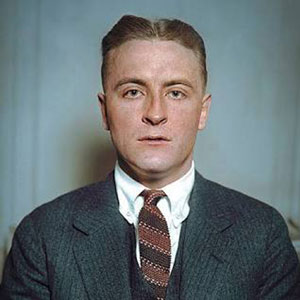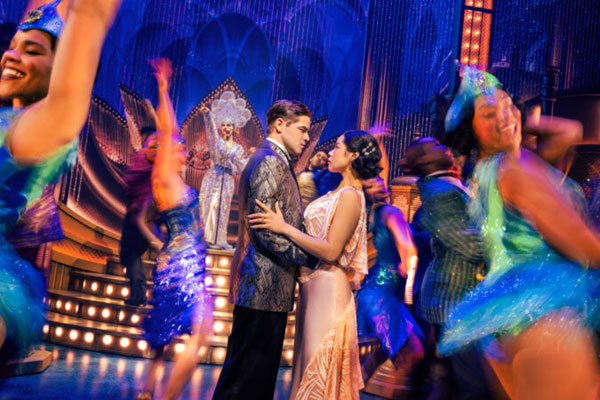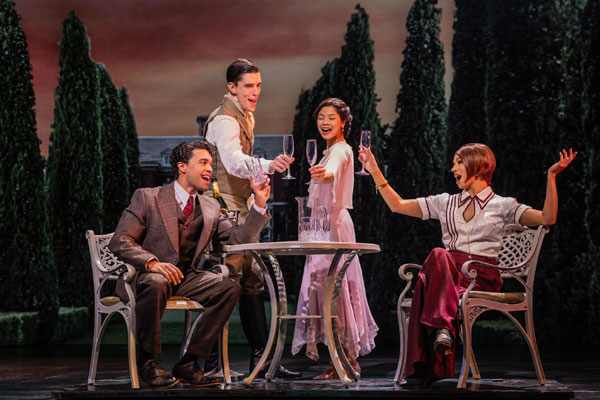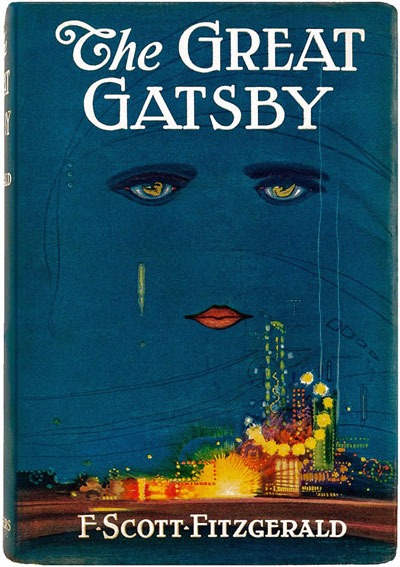|
And so we beat on, boats against the current,
borne back ceaselessly into the past.
With this indelible image F. Scott Fitzgerald closes his 1925 novel,
The Great Gatsby,
and these lines also close
the new musical, which has
just opened on Broadway,
based on
Fitzgerald’s work.
The theatre piece with a
book by Kate Kerrigan,
music by Jason Howland,
and lyrics by Nathan Tysen
is yet another adaptation
of Fitzgerald’s
classic, following in the
footsteps of among many -
two iconic movies, the
1999 John Harbison opera -
and preceding another
musical in the works now.
The fascination with the
doomed Romantic Jay Gatsby
and his Jazz Age world on
the brink of collapse
continues to lure
audiences almost one
hundred years later.

Yet, while the new Broadway show adheres literally to Fitzgerald’s
book in plot and in reverential retention of the most famous passages,
it veers from the spirit of the novel. Characters and motivations are
softened; the tone of cool observation the novel maintains by seeing
events through Nick Carraway’s eyes is forsaken for more immediacy
and overt passion, and the overwhelming sense of ennui that pervades
the Buchanans’ world is submerged in extroverted musical theatre
numbers that signal the abandon and excess of the era. For someone
who is a devotee of the novel, it takes several scenes to adjust to the
shift and to allow the musical to speak in its own voice. Once that
happens, the viewer can enjoy the production on its own terms, and
there is much to savor.
The music and lyrics are serviceable and stage savvy, allowing the
vocally strong cast of principals to each have moments to shine,
Despite the numerous opportunities for big production numbers, it is
the more introspective moments that tend to shine – the ballads like
Gatsby’s “For Her” or his duet with Daisy “My Green Light.”

Marc Bruni directs with a sure hand knowing how to maximize
dramatic impact, especially in the searing climax of the work, but he
never gets the cast to conjure up the careless people …..smashed up
things and creatures and then retreated back into their money or their
vast carelessness, or whatever it was that kept them together, and let
other people clean up the mess they had made. Instead, he creates a
more sympathetic world in which Gatsby and Daisy are a pair of star
-crossed lovers in a romantic tragedy. Dominique Kelley’s
choreography takes advantage of the striking set and the razzle dazzle
of the period to create lively dance moments, which, while de rigeur in
musicals, somehow seem at odds with the more measured tenor of
Fitzgerald’s work.
Paul Tate DePoo III’s visual production with lighting by Cory Pattak is
lush and stunning, using video and projections to change locales and
moods seamlessly. The glitter of the period contrasts effectively with
the atmospheric moments of yearning or the gritty neon reality of the
Valley of Ashes. Linda Cho’s costumes are appropriately glamorous,
eye-catching and opulent.

The eight principals and twenty person ensemble bring an electric
energy and commitment to the piece. As Jay Gatsby, Jeremy Jordan
turns in a performance worthy of his legendary status. He is both
endearing and elusive, idealistic and misguided, and he delivers a
master class in musical theatre singing. His solo numbers are
mesmerizing, and his duets are ardent and passionate. Eva Noblezada
matches him vocally with power, intensity and warmth, but her Daisy
seems too soft and likeable. Similarly, Samantha Pauly plays Jordan
Baker as an outspoken, liberated woman rather than the dishonest, self
-interested, aloof character of the novel. Noah J. Ricketts as Nick gives
a compelling vocal performance with memorable moments in
“Roaring On” and “The Met,” but his transformation from naïve acolyte
in Daisy’s world to disillusioned realist is not as gripping as it should be
.
The supporting characters are all well-limned. John Zdrojeski is
suitably brutish as Tom Buchanan; Sara Chase makes an especially
heart wrenching Myrtle Wilson; Paul Whitty is poignant as her
betrayed husband George, and Eric Anderson as Meyer Wolfsheim gets
a darkly comic moment in “Shady” to regal the audience with his song
and dance talents.

Judging by the Broadway audience response shortly after opening, The
Great Gatsby continues to lure audiences into its world. Like the
elusive green light on Daisy’s dock, the tale of a hopeless romantic
poised on the brink of destruction in a post-world-war gone mad
seems timeless in its ability to capture the imagination. If this latest
musical theatre version is not a pristine rendering of Fitzgerald’s novel,
perhaps that is because Fitzgerald’s protagonist Gatsby is so very
elusive. The sadly noble Romanticism of the character, his dissonance
with a world that is empty and ugly, and his obsessive quest stand in
sharp contrast to the hedonistic, self-serving amorality of the
Buchanans’ world. But without the ability that Nick Carraway
ultimately achieves to shed the rose-colored glasses and accept a hard,
cold reality, Gatsby becomes a tragic hero. And in his loneliness and
isolation, standing at the end of his dock, reaching out to the green
light, he becomes a powerful symbol of both unfulfilled dreams and
eternal hope.
The Great Gatsby is currently playing at the Broadway Theatre, 1681
Broadway, NY, NY
|